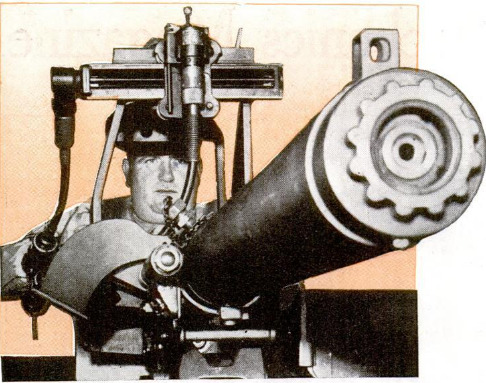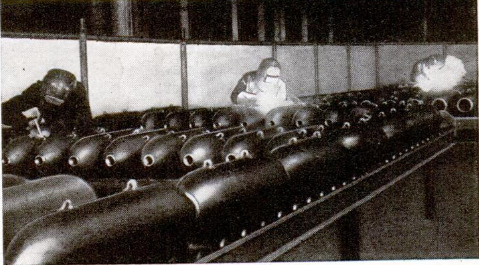ONE plane every four minutes, one war tank every seven minutes and two ships a day - that, in a nutshell, is the All-Out-For-Victory goal set for America’s manufacturers and workers. To carry the war to the enemy's home ground and hit him again and again wherever we can reach him, the President has called for the production of 60,000 planes this year and 125,000 next year, 45,000 tanks this year and 75,000 next year, 20,000 antiaircraft guns this year and 35,000 next year, and 8,000,000 tons of merchant shipping this year and 10,000,000 tons in 1943, The word “if” cannot even be considered - we MUST turn out one plane every four minutes, one tank every seven minutes and fractionally more than two ships every day next year. In the aircraft industry, this program means spectacular increases in employment and floor space. Back in 1940 we had about 190,000 men and women building planes, but for 1943 we must have approximately 1,390,000 on the job. Vast1y greater floor space will be necessary, of course. This expansion may be estimated at about 100,000,000 square feet of floor space, with the ultimate area devoted to military plane production some three times the area in use at the beginning of 1942. Some reliable sources recently estimated our plane production at 2,500 per month, or 30,000 per year. What the figures are now is a military secret, but we all know that the rate of production must be close to 7,500 planes every 30 days before the end of this year and must approach 12,500 planes per month before the end of 1943. In comparison, the monthly output a year ago was 1,000. And, also in comparison, the Axis nations - Germany, Italy and Japan - will produce about 40,000 planes this year, perhaps a few more or a few less. Taking all of these figures for their face value, it seems reasonable to believe that the United States will equal or surpass Axis’ production by the middle, or soon thereafter, of this year and increase rapidly to give the Allies that superiority so desirable in the air. Many authorities consider air supremacy as the key to victory, pointing to successful German and Japanese operations as evidence of the soundness of their opinion. To a vast section of our population the problems surrounding the production of fighting planes are hard to comprehend. Many Americans think it should be as easy to build a million airplanes - and in as short a time - as to construct a million automobiles. They know, of course, that more than one Detroit manufacturer has been able to produce a million cars a year. What they don't realize is that an airplane, particularly one capable of fighting the best our enemies can build, is vastly more complicated in construction and requires special instruments and equipment not needed in the automobile. In addition, the factory space must be vastly greater than anyone ever dreamed of before the industry can turn out 185,000 planes in two years. Another factor is the cost. A training plane means an expenditure of about $25,000, a fighter costs approximately $50,000 and bombing planes from $100,000 to $300,000. And the costs are still rising because power turrets for guns and other modifications are necessary in many military aircraft, as well as machine guns and cannon, central firing controls, bomb sights and automatic flight controls, while for high-flying planes there must be oxygen and pressure-cabin equipment. Everyone knows about the engine in his automobile. Well, an airplane engine has about ten times the power and costs 100 times as much as an automobile engine. That's because it must be constructed of the very best metals and other materials and must be built to very close working limits, or tolerances. Where the automobile engine operates nicely with its parts fitted to 1/10,000 of an inch, the airplane engine calls for a closer fit, perhaps 1/100,000 of an inch. Again, the aircraft power plant’s weight must be held down, for obvious reasons, but its horsepower must be high. When you consider that combat planes average from two to three engines apiece, ranging from one-engine craft to four-engine bombers, plus some 33 percent more for replacements, and that each engine costs from $15,000 to $25,000, you begin to get an idea of the problem. No one would reveal production figures on any single classification of combat plane; that’s information the enemy would be only too glad to get. So suppose we consider the problem of turning out 500 four-engine bombing planes - of the type that would be valuable in long-range attacks. If the goal were 500 of these per month, not less than 400,000 workers would be needed to do the job and not less than ten tons of aluminum would be required for each plane. If, at the end of 1942, the United States should have 50,000 fighting planes in service, two to three men per plane would be necessary, figuring that some types of planes are good for more hours in the air than one pilot can stand and that bombing planes carry five to nine men each. Thus, we would need a flying personnel of 150,000. A much larger personnel is required on the ground, perhaps bringing the total to 1,000,000 men. This looks like another problem, but our government already is taking steps to work out the solution before the problem presents itself. Under a recently announced program, the air force is being expanded to 2,000,000 men, with about 50 percent of them in service before the end of the year. Such a force is about twice as large as Germany’s famous Luftwaffe, as well as double the size of Britain’s Royal Air Force. Certainly it is far superior in numbers to Japan's air arm. Uncle Sam’s big hurdle at this point appears to be the training of 2,000,000 pilots and ground men. They must all be specialists - expert mechanics, navigators, bombardiers, pilots, weather men, radio operators and supply men. To become specialists, they must be trained for several months, as in the case of the aviation mechanic whose required course under present conditions runs about five months. This means a very considerable expansion of every type of school doing this kind of work, as well as the establishment of new training centers. What our armed services could accomplish with just half the number of combat planes contemplated - 92,000 - is only a matter of conjecture. Anyone knows that 1,000 planes, with full personnel and equipment, can mean the difference between victory and defeat - if the planes are in the right place at the right time. In the largest continuous blitz on London, some 500 planes were employed, some military experts estimate. Of course this does not mean that 500 planes were over the British capital at any one time; possibly this raid was prosecuted with as few as 100 planes working in relays. And there are few indications that Japan has used more than 100 planes in any single attack. The Royal Air Force bombed Cologne with a reported 1,250 planes. In contrast, what would be the result of an attack by 5,000 Yankee bombing and fighting planes on an objective - perhaps a gigantic raid on Tokyo some moonlight night? The reader will have to use his imagination here because nothing like it has ever been attempted. But it’s worth thinking about because we - the manufacturers, the airplane workers and the air force personnel - are going to make it a possibility. From the National Association of Manufacturers comes the information that to meet the President’s goal of 8,000,000, tons of merchant shipping in 1942, it would be necessary to sustain a rate of approximately two ships a day. In comparison, this country produced 13,627,311 tons of shipping during the World War when we were preparing to transfer 4,000,000 troops overseas. At the end of 1941 shipyards in the United States had under construction 833 seagoing merchant vessels, of which more than 700 would have to be completed this year. Two years ago there were only 83 ways in this country capable of accommodating vessels more than 300 feet in length, according to the American Bureau of Shipping. This meant a capacity of about 160 ships per year. Early in 1941, there were 170 building ways and today there are more than 400 that can be used for constructing steel seagoing vessels. To some extent, these facilities are taken up by Naval construction. When Japan struck we had 17 battleships and 15 more building, seven aircraft carriers and 11 building, 37 cruisers and 54 building, 171 destroyersand 183 building, and 113 submarines and 73 being built - under our program of a “two-ocean” navy. Along with the increase in building ways has been a comparable growth of drydocks, machine shops, fitting-out piers and the other buildings needed in a shipyard. This rapid growth has required large-scale expansion in allied industries - for instance, steel shapes, boilers, turbines, pumps and machinery. The employment increase in the shipbuilding industry is on the order of 500,000 - from an estimated 240,700 at work at the beginning of 1941 to an estimated 740,000 necessary to attain the goal set by our government. Production of tanks and combat vehicles is more than three times that of a year ago, according to the Office of Facts and Figures, giving our army the mobility needed for offensive action. The rate of tank production has been pyramiding and, at present, far exceeds estimates of a year ago. The 1942 goal of 45,000 tanks is great enough to equip and maintain with replacements more than 60 armored divisions - in action. From where we stand it seems that the United States is on its way toward outbuilding the world in planes and tanks - the two most important weapons in this war. But it's a herculean task - one in which every man, woman and child can, and must play a part.




